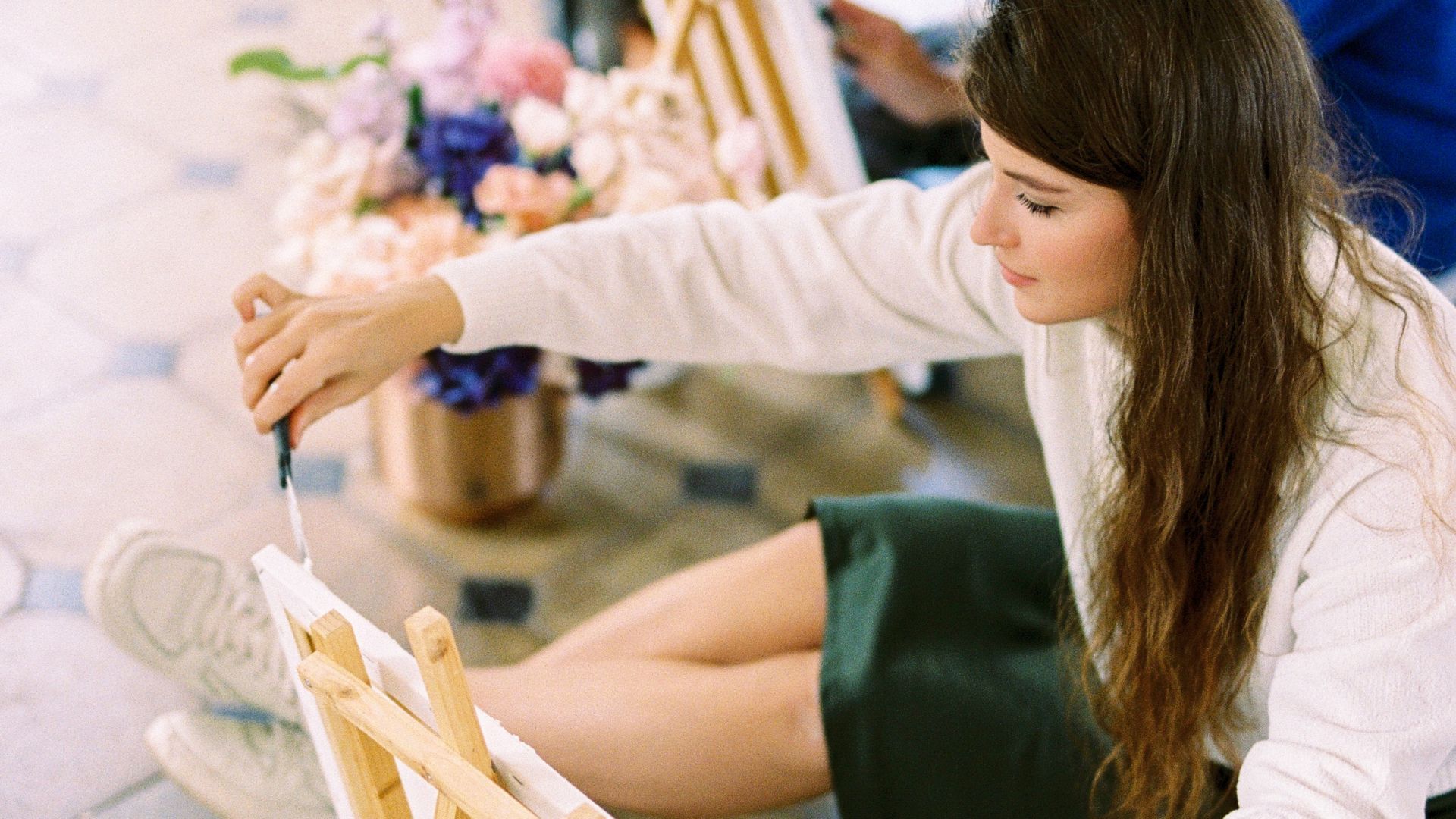If you’re an aspiring artist or someone enthusiastic about trying their hand at painting, you might wonder if you can paint over an existing wall paint on a canvas. The short answer? Yes, you can! Painting over an already painted canvas is a common practice among artists, whether they’re beginners experimenting with their skills or seasoned creators looking to repurpose old canvases.
Why Paint Over Existing Wall Paint on Canvas?
There are several reasons why you might consider painting over an existing canvas:
1. Repurposing and Recycling:
Sometimes, an old painting might not align with your current artistic vision. Instead of discarding the canvas, painting over it allows you to repurpose and give it a new life.
2. Experimentation and Layering:
Artists often build layers of paint to add depth, texture, and complexity to their work. Painting over an existing canvas allows for experimentation and the creation of unique effects.
3. Cost-Efficiency:
Purchasing new canvases can add up. By reusing an old canvas, you save money and reduce waste.
Steps to Paint Over Existing Wall Paint on Canvas:
1. Prepare the Canvas:
- Ensure the canvas is clean and free of dust or debris. A gentle wipe with a clean, damp cloth can help.
- If the previous painting has a rough texture or dried paint clumps, sanding the surface lightly can create a smoother base.

2. Prime the Surface:
- Applying a primer helps create an even base for your new painting. Choose a primer suitable for acrylic or oil paints, depending on your preference.
3. Start Painting:
- Once the primer is dry, you’re ready to begin your new artwork! Let your creativity flow and start painting your desired subject or scene.
4. Layering Techniques:
- Experiment with layering techniques to incorporate elements of the previous painting into your new creation. You can partially scrape, blend, or let hints of the underlying painting show through for added depth.
5. Final Touches:
- Once you’re satisfied with your new artwork, allow it to dry completely before adding any finishing touches or protective varnish.
Additional Tips:
- Color Consideration: Consider how the previous paint might affect your new colors. For example, painting light colors over a dark base might require multiple coats.
- Allow Drying Time: Patience is key! Allow each layer of paint, including the primer, to dry thoroughly before adding the next.
- Explore and Have Fun: Don’t be afraid to experiment. Painting over an existing canvas can lead to unexpected and exciting results.
External Resources for Further Guidance:
- The Spruce Crafts – How to Paint Over an Old Canvas
- Artists Network – Repurposing an Old Painting
- Winsor & Newton – Tips for Reusing Old Canvases
So,….
Painting over existing wall paint on canvas is not only feasible but also a fantastic way to explore your creativity, save resources, and breathe new life into old artwork. So, grab your brushes, let your imagination flow, and turn that canvas into a masterpiece of your own.
let’s delve deeper into some common questions that might arise when considering painting over existing wall paint on a canvas.
Frequently Asked Questions:
1. Can I Paint Over an Oil Painting with Acrylics or Vice Versa?
- Yes, you can paint acrylics over oil paints, but it’s advisable not to paint oils over acrylics directly. The general rule is that oil paint needs a porous surface to adhere to, so acrylics (which create a non-porous surface when dry) might not provide the ideal base for oils.
2. What if the Previous Painting Has Texture or Thick Layers?
- Sanding the surface gently can help smooth out textures or remove thick layers. However, embracing the texture or incorporating it into your new artwork can also yield interesting results.
3. Do I Need to Use Gesso as a Primer?
- While gesso is commonly used as a primer, especially for acrylic paints, you can also opt for specific primers formulated for acrylics or oils. Gesso provides a good base for both types of paint.
4. Will the Previous Painting Show Through?
- The extent to which the previous painting shows through depends on factors like the opacity of your new paint, the colors used previously, and your layering technique. Embrace it as part of the creative process or cover it completely with multiple layers.
5. Can I Remove the Existing Paint Completely?
- It’s possible to remove paint from a canvas, but it might involve harsh solvents or techniques that can damage the canvas. Unless it’s necessary, painting over the existing paint is a more practical approach.
So,…
Painting over existing wall paint on canvas opens a realm of possibilities for artists. It’s a sustainable, cost-effective way to create new artwork while preserving the essence of the old. Remember, every stroke you make contributes to the narrative of your art, whether you choose to conceal the past layers or let them peek through.
Exploring the world of repurposing canvases not only encourages creativity but also showcases the resilience and adaptability of art. So, grab your favorite paints, embrace the creative journey, and transform that canvas into something extraordinary.
And always remember, art knows no boundaries. The canvas is your playground paint your story, layer by layer.
Comparison tabular
Here’s a comparison table summarizing the key aspects of painting over existing wall paint on canvas:
| Aspect | Painting Over Existing Wall Paint on Canvas |
|---|---|
| Purpose | Repurposing old canvases, experimentation, cost-efficiency |
| Preparation | Clean the canvas, sand if needed, apply primer for a smooth base |
| Paint Compatibility | Acrylics can be painted over oils; avoid painting oils over acrylics directly |
| Texture and Layering | Embrace or smooth out existing textures; experiment with layering techniques |
| Priming | Gesso or specific primers suitable for acrylics/oils |
| Previous Paint Visibility | Depends on opacity, colors used, and layering technique |
| Removing Existing Paint | Possible but may damage the canvas; painting over is more practical |
| Considerations | Color impact of previous paint, drying time between layers |
| Result | New artwork with potential hints of the old, a sustainable creative process |
This comparison table provides a quick overview of the various aspects involved in painting over existing wall paint on canvas, highlighting its purpose, preparation steps, paint compatibility, considerations, and the resulting artwork’s nature.
Wrapping up
As you embark on the journey of painting over existing wall paint on canvas, remember that each stroke holds the promise of a new narrative. Embrace the canvas as a storyteller, weaving layers of color and texture to create your masterpiece.
Whether you’re repurposing an old canvas, exploring new techniques, or simply letting your creativity flow, this process is a testament to the resilience of art. It’s an opportunity to transform the old into something fresh and captivating, breathing life into your imagination.
So, pick up your brushes, blend your colors, and let the canvas be your canvas a space where the past and present converge to form something beautifully unique. Enjoy every moment of this artistic endeavor, for in each layer lies a tale waiting to be told.
May your artistic endeavors be filled with joy, discovery, and boundless creativity. Happy painting!

For over a decade, I’ve been Mike, an artist, crafter, and designer deeply immersed in the Croc world. I thrive on crafting unique, size-inclusive patterns, fostering creativity, and sharing them on ktforum.com. My designs aim to ignite your creative spark and delight you, ensuring clarity and ease of use through rigorous testing. Join me in expressing your creative flair and showcasing your craft with joy.
Related Posts
- Exploring Temporary Art with Wall Paint on Canvas
When it comes to art, experimentation knows no bounds. Have you ever considered using wall…
- Should You Sand a Canvas Before Painting it with Wall Paint
When it comes to using wall paint on canvas, the question of sanding often arises.…
- Is Wall Paint Suitable for Canvas
Absolutely. Using wall paint on canvas is entirely possible and can produce some fantastic results.…
- Testing Wall Paint on Canvas: A Smart Approach to Your Painting Project
When it comes to transforming a canvas into a masterpiece, choosing the right paint is…

